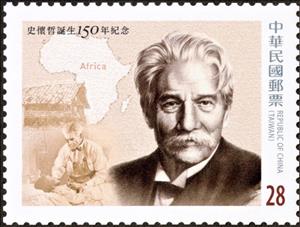Stamp: Albert Schweitzer (Taiwan (Republic of China) 2025)
Albert Schweitzer (Taiwan (Republic of China) 2025)
28 March (Taiwan (Republic of China) ) within release Albert Schweitzer goes into circulation Stamp Albert Schweitzer face value 28 Taiwanese new dollar
| Stamp Albert Schweitzer in catalogues | |
|---|---|
| Colnect codes: | Col: TW 2025.03.28-01 |
Stamp is horizontal format.
Also in the issue Albert Schweitzer:
- Stamp - Albert Schweitzer face value 28;
- Full Pane - Albert Schweitzer face value 10*28;
Stamp Albert Schweitzer it reflects the thematic directions:
A map is a symbolic depiction emphasizing relationships between elements of some space, such as objects, regions, or themes. Many maps are static, fixed to paper or some other durable medium, while others are dynamic or interactive. Although most commonly used to depict geography, maps may represent any space, real or imagined, without regard to context or scale, such as in brain mapping, DNA mapping, or computer network topology mapping. The space being mapped may be two dimensional, such as the surface of the earth, three dimensional, such as the interior of the earth, or even more abstract spaces of any dimension, such as arise in modeling phenomena having many independent variables. Although the earliest maps known are of the heavens, geographic maps of territory have a very long tradition and exist from ancient times. The word "map" comes from the medieval Latin Mappa mundi, wherein mappa meant napkin or cloth and mundi the world. Thus, "map" became the shortened term referring to a two-dimensional representation of the surface of the world.
A physician, medical practitioner (British English), medical doctor, or simply doctor is a health professional who practices medicine, which is concerned with promoting, maintaining or restoring health through the study, diagnosis, prognosis and treatment of disease, injury, and other physical and mental impairments. Physicians may focus their practice on certain disease categories, types of patients, and methods of treatment—known as specialities—or they may assume responsibility for the provision of continuing and comprehensive medical care to individuals, families, and communities—known as general practice. Medical practice properly requires both a detailed knowledge of the academic disciplines, such as anatomy and physiology, underlying diseases, and their treatment, which is the science of medicine, and a decent competence in its applied practice, which is the art or craft of the profession.


